SIT60316 Advanced Diploma of Hospitality Management
VerifiedAdded on 2021/08/10
|24
|1924
|123
AI Summary
Contribute Materials
Your contribution can guide someone’s learning journey. Share your
documents today.
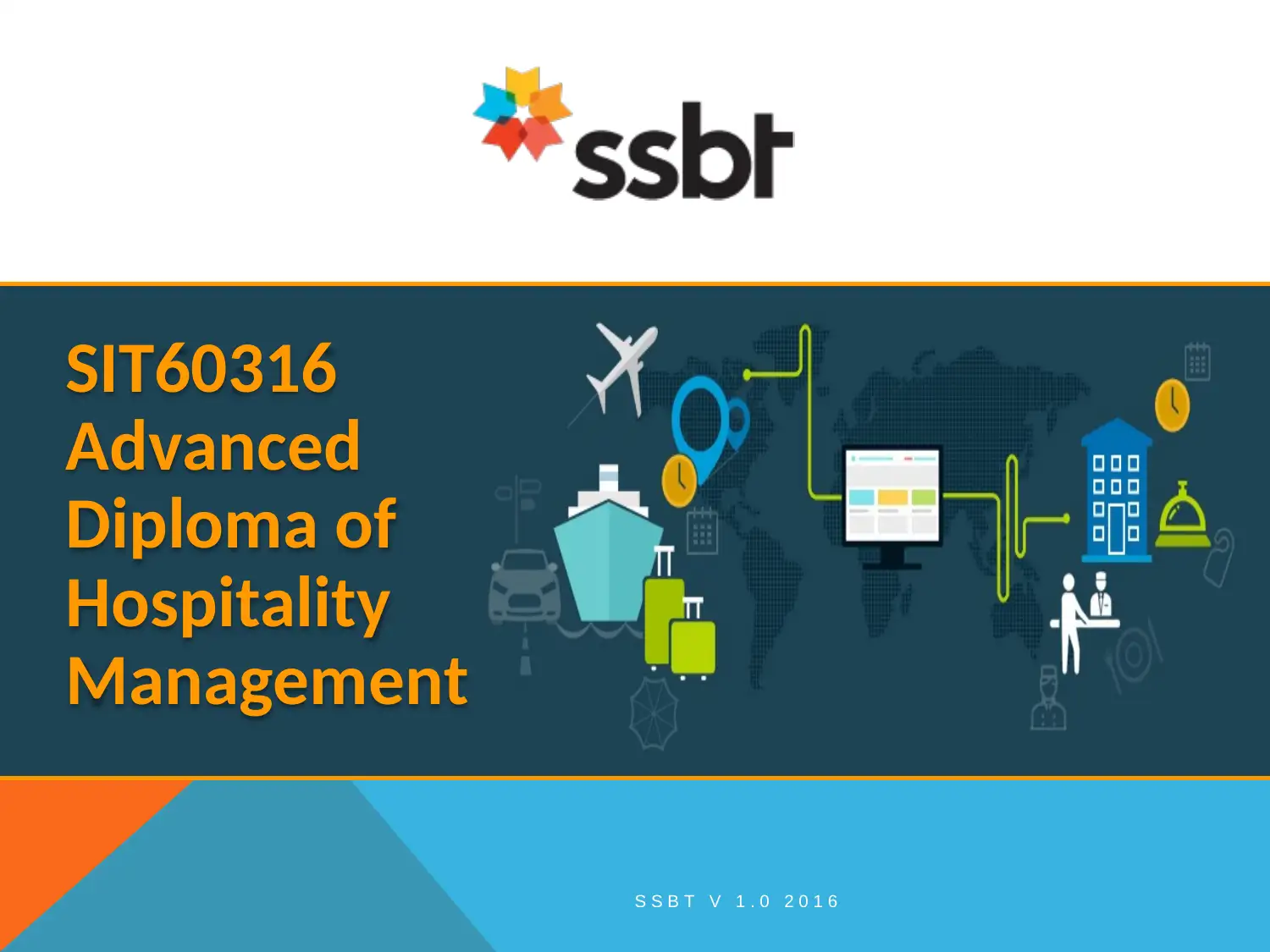
S S B T V 1 . 0 2 0 1 6
SIT60316
Advanced
Diploma of
Hospitality
Management
SIT60316
Advanced
Diploma of
Hospitality
Management
Secure Best Marks with AI Grader
Need help grading? Try our AI Grader for instant feedback on your assignments.
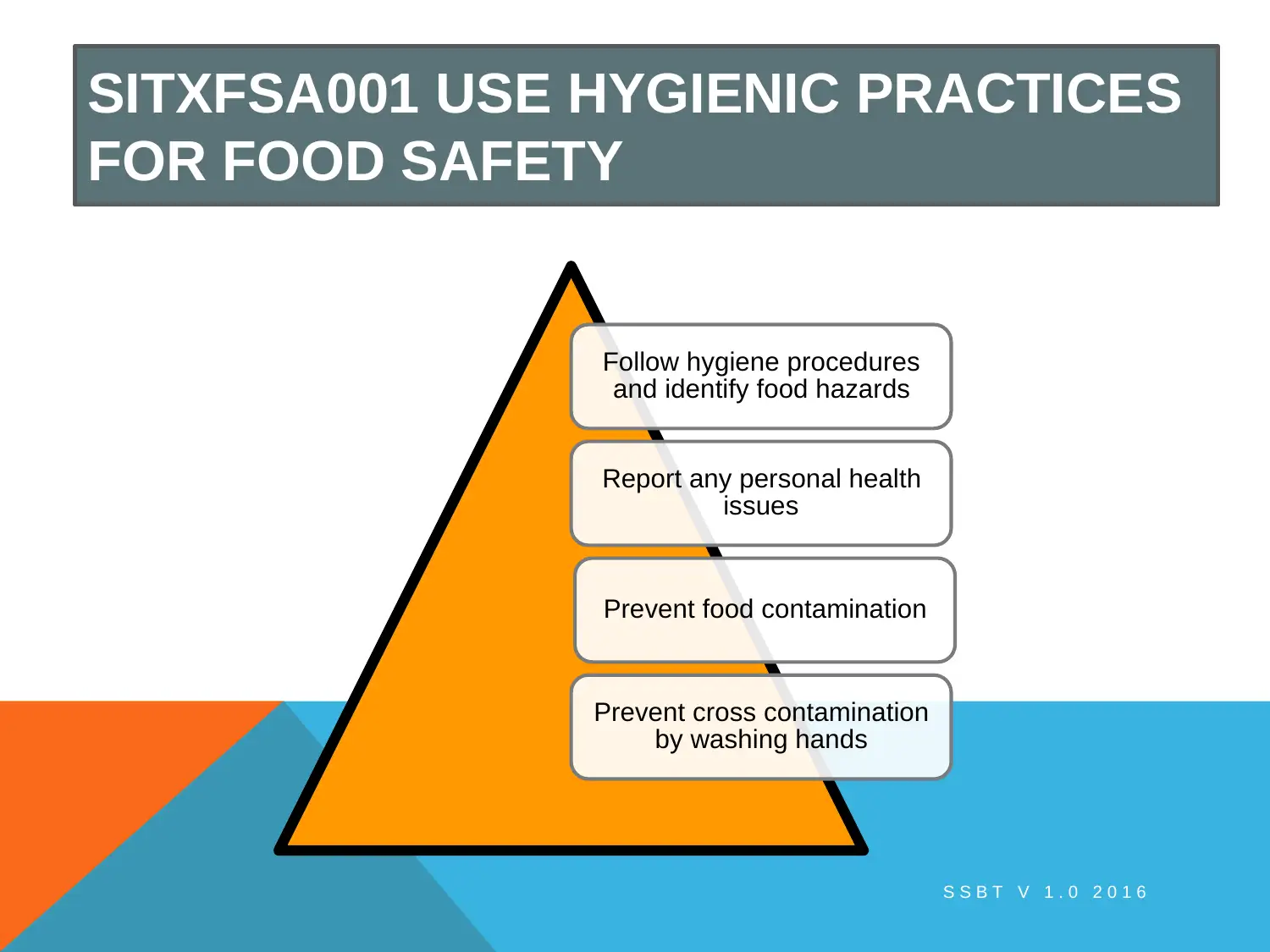
SITXFSA001 USE HYGIENIC PRACTICES
FOR FOOD SAFETY
Follow hygiene procedures
and identify food hazards
Report any personal health
issues
Prevent food contamination
Prevent cross contamination
by washing hands
S S B T V 1 . 0 2 0 1 6
FOR FOOD SAFETY
Follow hygiene procedures
and identify food hazards
Report any personal health
issues
Prevent food contamination
Prevent cross contamination
by washing hands
S S B T V 1 . 0 2 0 1 6
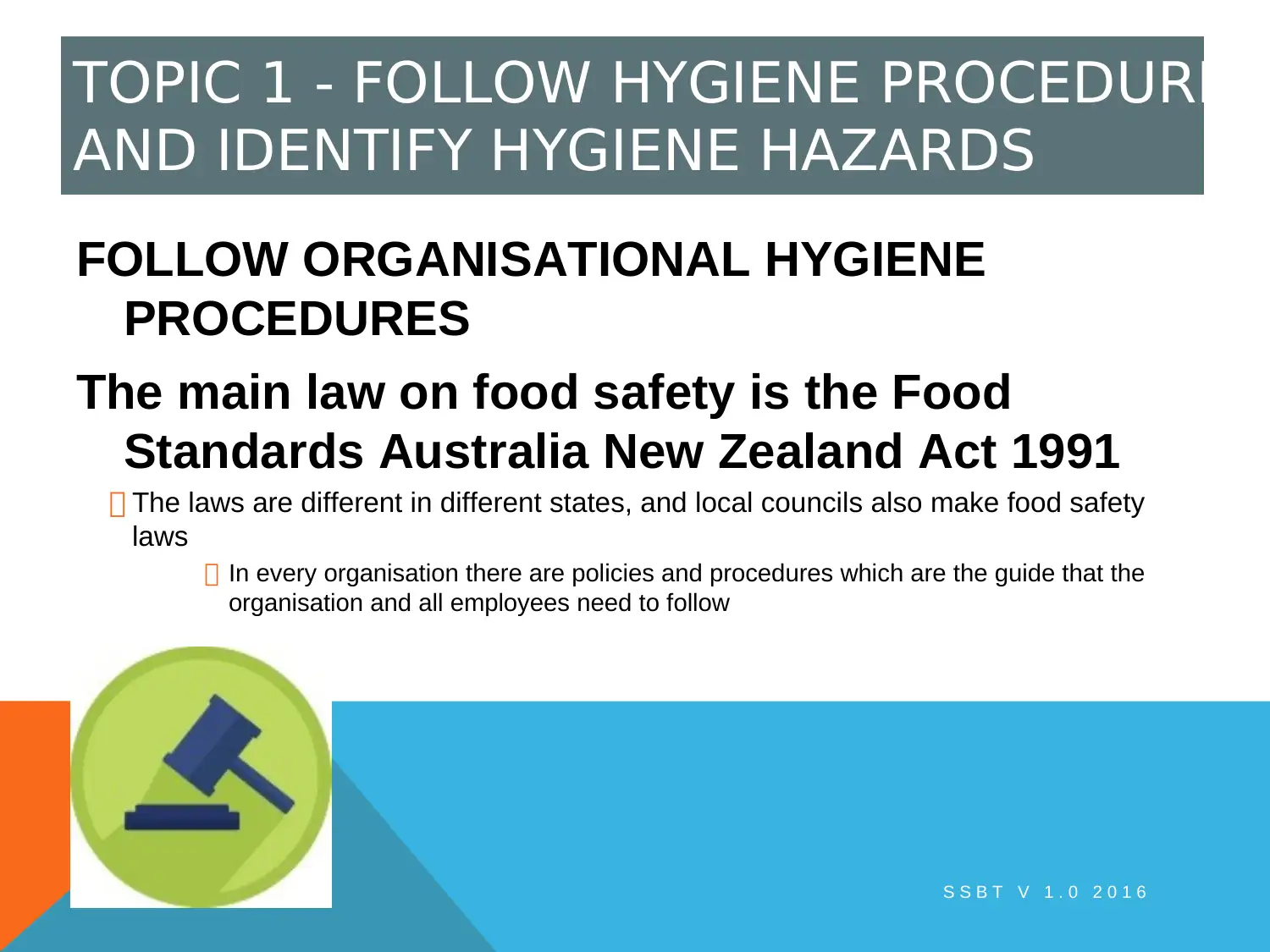
TOPIC 1 - FOLLOW HYGIENE PROCEDURES
AND IDENTIFY HYGIENE HAZARDS
FOLLOW ORGANISATIONAL HYGIENE
PROCEDURES
The main law on food safety is the Food
Standards Australia New Zealand Act 1991
The laws are different in different states, and local councils also make food safety
laws
In every organisation there are policies and procedures which are the guide that the
organisation and all employees need to follow
S S B T V 1 . 0 2 0 1 6
AND IDENTIFY HYGIENE HAZARDS
FOLLOW ORGANISATIONAL HYGIENE
PROCEDURES
The main law on food safety is the Food
Standards Australia New Zealand Act 1991
The laws are different in different states, and local councils also make food safety
laws
In every organisation there are policies and procedures which are the guide that the
organisation and all employees need to follow
S S B T V 1 . 0 2 0 1 6

WHAT IS HAZARD ANALYSIS CRITICAL
CONTROL POINT? (HACCP)
HACCP (Hazard Analysis Critical Control
Point) is the systematic preventative
approach to food safety
It addresses physical, chemical, and biological hazards as a means of prevention
rather than finished product inspection
This approach has significant benefits to organisations operating within the food supply
chain as it enables them to determine key controls over processes and concentrate
resources on activities that are critical to ensuring safe food
S S B T V 1 . 0 2 0 1 6
CONTROL POINT? (HACCP)
HACCP (Hazard Analysis Critical Control
Point) is the systematic preventative
approach to food safety
It addresses physical, chemical, and biological hazards as a means of prevention
rather than finished product inspection
This approach has significant benefits to organisations operating within the food supply
chain as it enables them to determine key controls over processes and concentrate
resources on activities that are critical to ensuring safe food
S S B T V 1 . 0 2 0 1 6
Secure Best Marks with AI Grader
Need help grading? Try our AI Grader for instant feedback on your assignments.
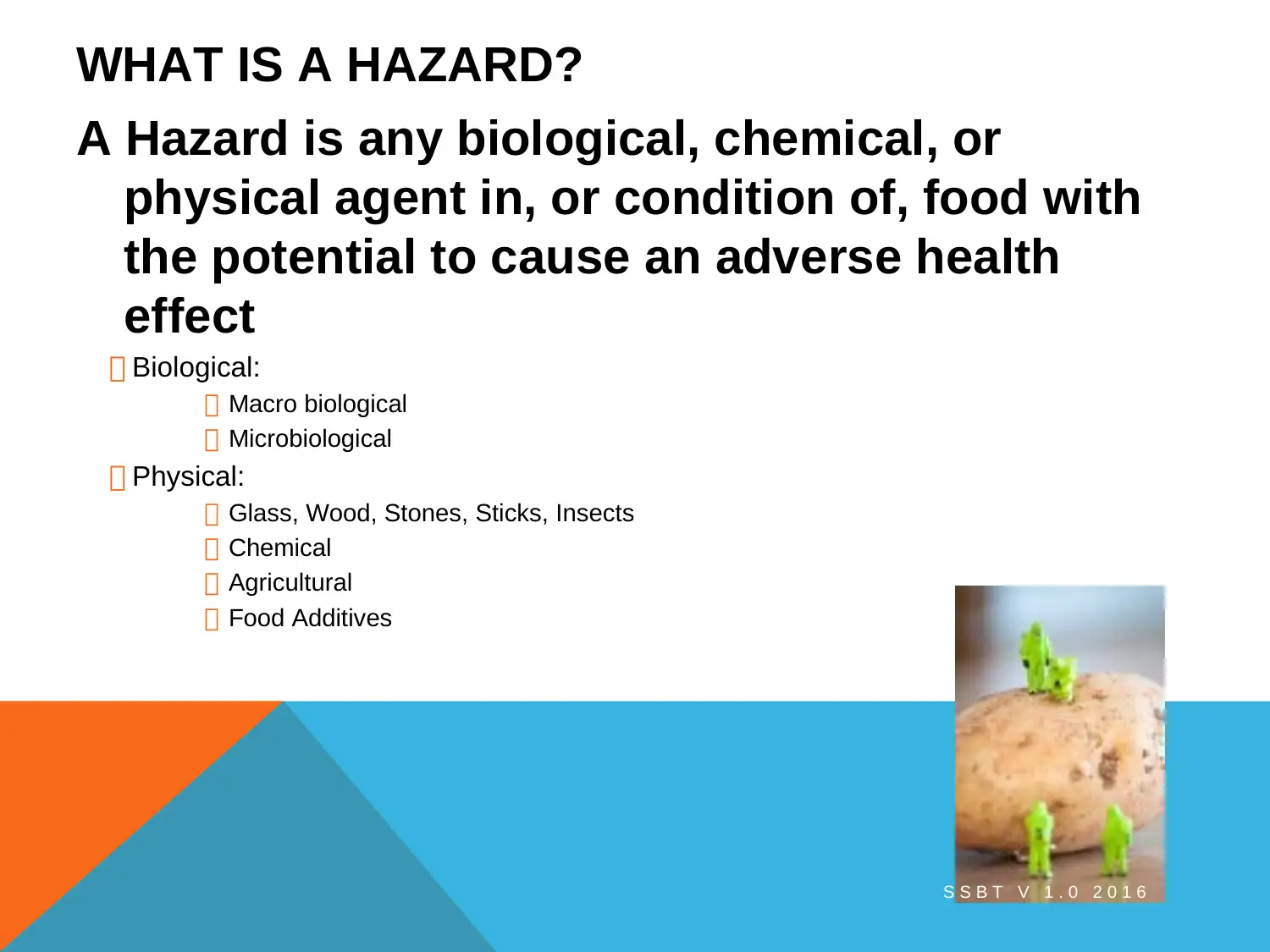
WHAT IS A HAZARD?
A Hazard is any biological, chemical, or
physical agent in, or condition of, food with
the potential to cause an adverse health
effect
Biological:
Macro biological
Microbiological
Physical:
Glass, Wood, Stones, Sticks, Insects
Chemical
Agricultural
Food Additives
S S B T V 1 . 0 2 0 1 6
A Hazard is any biological, chemical, or
physical agent in, or condition of, food with
the potential to cause an adverse health
effect
Biological:
Macro biological
Microbiological
Physical:
Glass, Wood, Stones, Sticks, Insects
Chemical
Agricultural
Food Additives
S S B T V 1 . 0 2 0 1 6
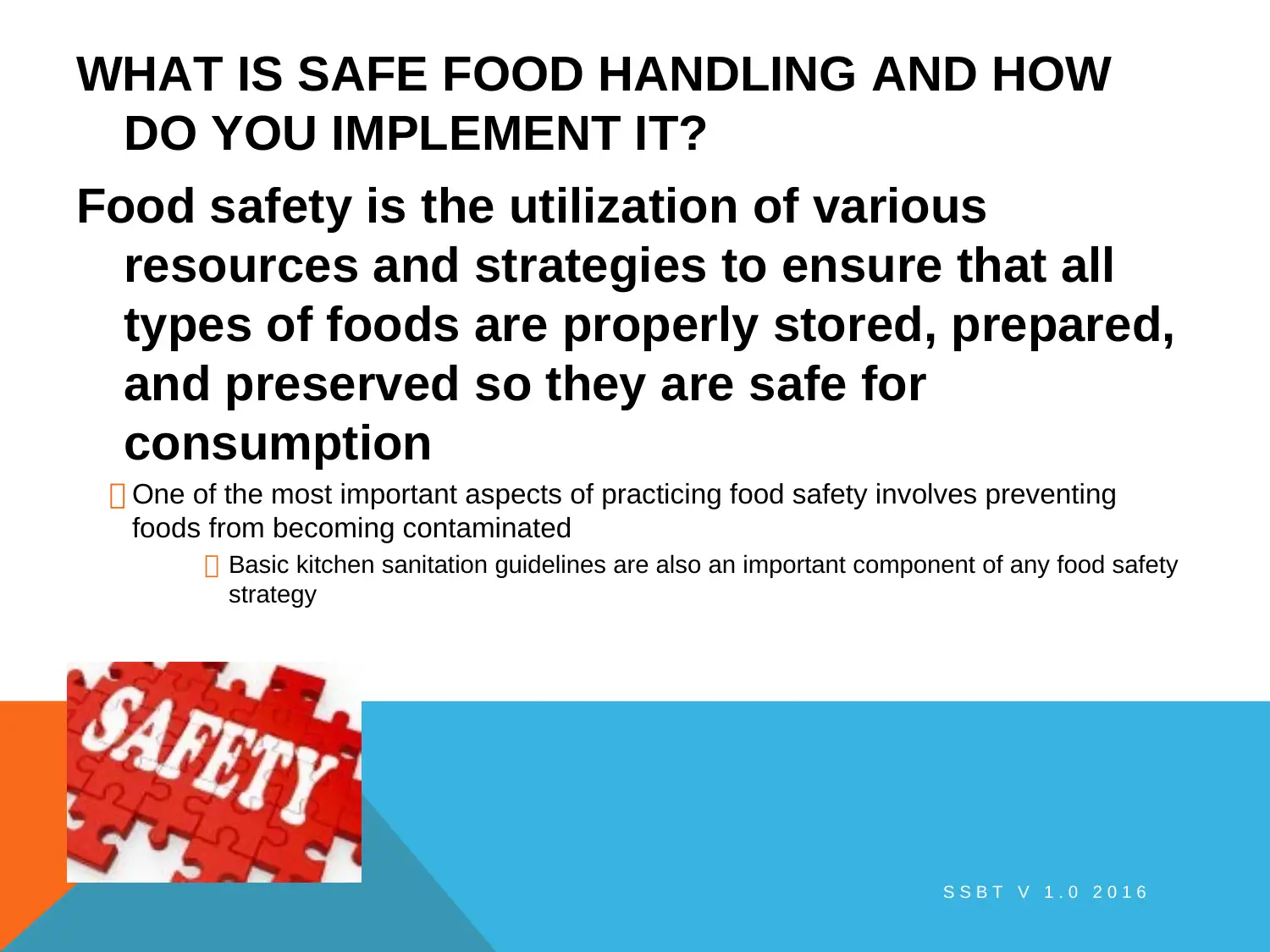
WHAT IS SAFE FOOD HANDLING AND HOW
DO YOU IMPLEMENT IT?
Food safety is the utilization of various
resources and strategies to ensure that all
types of foods are properly stored, prepared,
and preserved so they are safe for
consumption
One of the most important aspects of practicing food safety involves preventing
foods from becoming contaminated
Basic kitchen sanitation guidelines are also an important component of any food safety
strategy
S S B T V 1 . 0 2 0 1 6
DO YOU IMPLEMENT IT?
Food safety is the utilization of various
resources and strategies to ensure that all
types of foods are properly stored, prepared,
and preserved so they are safe for
consumption
One of the most important aspects of practicing food safety involves preventing
foods from becoming contaminated
Basic kitchen sanitation guidelines are also an important component of any food safety
strategy
S S B T V 1 . 0 2 0 1 6
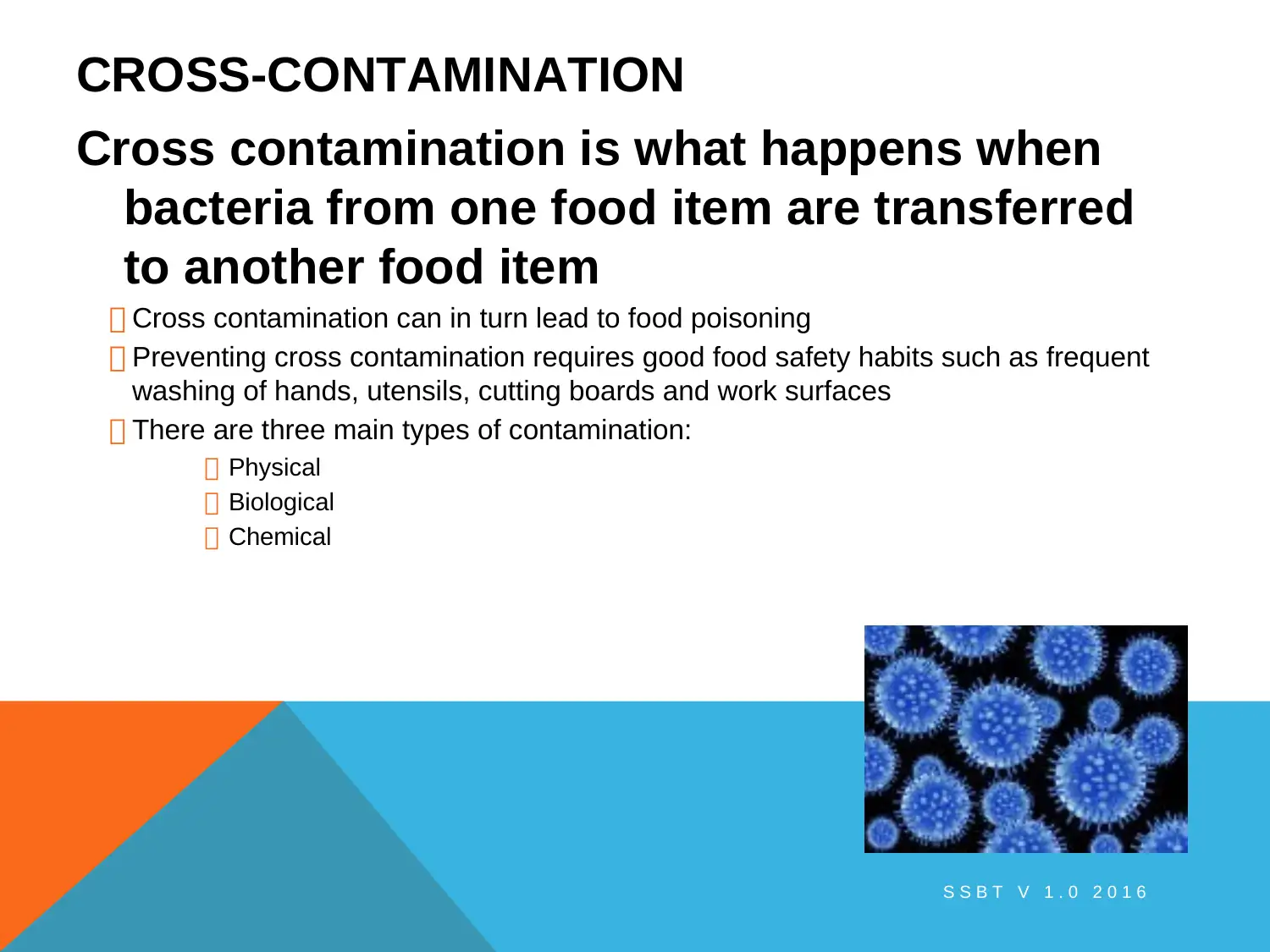
CROSS-CONTAMINATION
Cross contamination is what happens when
bacteria from one food item are transferred
to another food item
Cross contamination can in turn lead to food poisoning
Preventing cross contamination requires good food safety habits such as frequent
washing of hands, utensils, cutting boards and work surfaces
There are three main types of contamination:
Physical
Biological
Chemical
S S B T V 1 . 0 2 0 1 6
Cross contamination is what happens when
bacteria from one food item are transferred
to another food item
Cross contamination can in turn lead to food poisoning
Preventing cross contamination requires good food safety habits such as frequent
washing of hands, utensils, cutting boards and work surfaces
There are three main types of contamination:
Physical
Biological
Chemical
S S B T V 1 . 0 2 0 1 6
Paraphrase This Document
Need a fresh take? Get an instant paraphrase of this document with our AI Paraphraser

BACTERIAL GROWTH AND THE DANGER
ZONE
Bacteria are microorganism’s that is found on
every single exposed surface
It is a simple thing that can expand at a rapid rate to create a larger problem
Bacteria have a number of certain elements that will excel in their growth:
Time
Temperature – bacteria is best grown between
5*C - 60*C. This is known as the danger zone
Nutrients
Water
Light
PH
S S B T V 1 . 0 2 0 1 6
ZONE
Bacteria are microorganism’s that is found on
every single exposed surface
It is a simple thing that can expand at a rapid rate to create a larger problem
Bacteria have a number of certain elements that will excel in their growth:
Time
Temperature – bacteria is best grown between
5*C - 60*C. This is known as the danger zone
Nutrients
Water
Light
PH
S S B T V 1 . 0 2 0 1 6
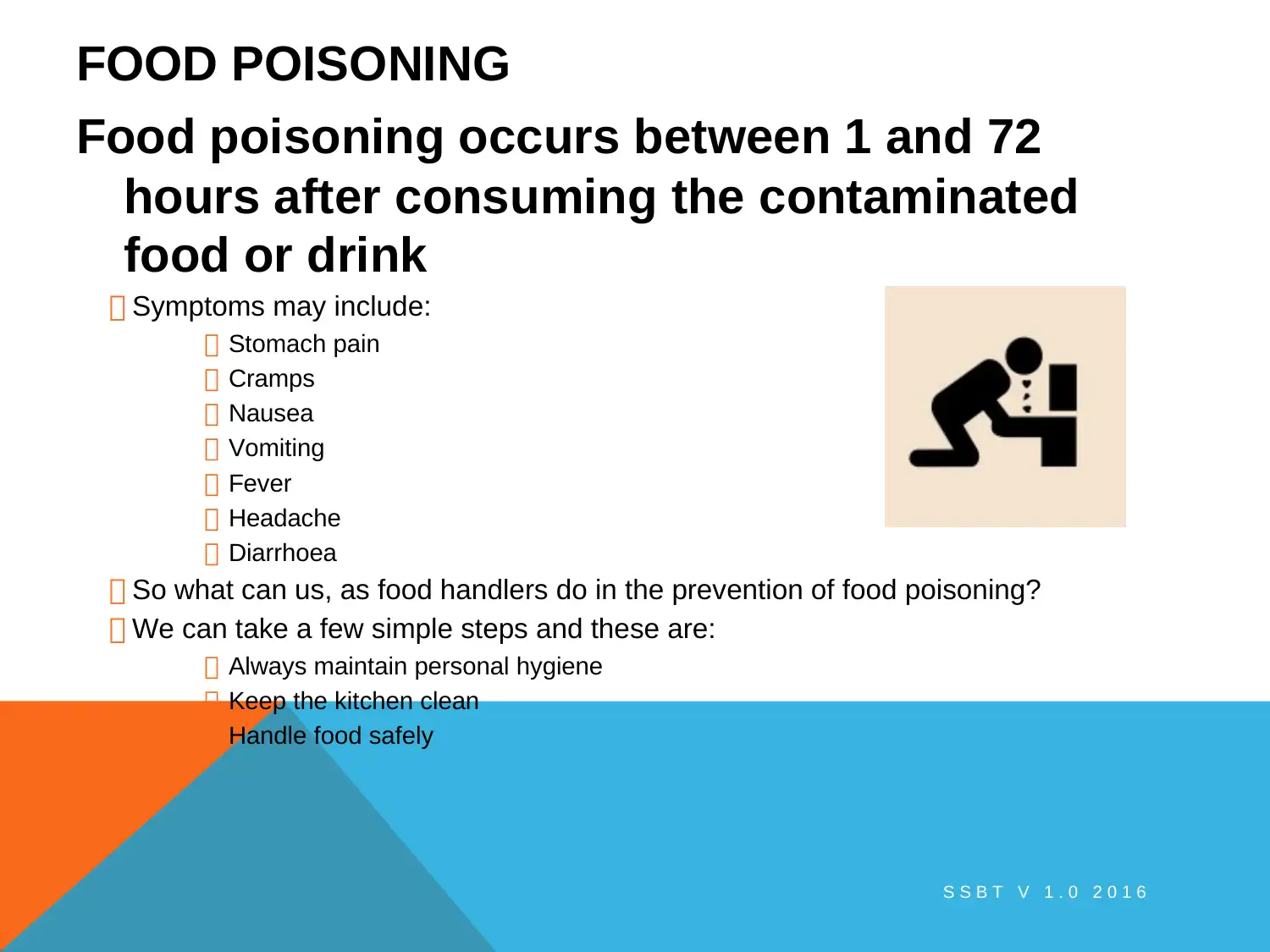
FOOD POISONING
Food poisoning occurs between 1 and 72
hours after consuming the contaminated
food or drink
Symptoms may include:
Stomach pain
Cramps
Nausea
Vomiting
Fever
Headache
Diarrhoea
So what can us, as food handlers do in the prevention of food poisoning?
We can take a few simple steps and these are:
Always maintain personal hygiene
Keep the kitchen clean
Handle food safely
S S B T V 1 . 0 2 0 1 6
Food poisoning occurs between 1 and 72
hours after consuming the contaminated
food or drink
Symptoms may include:
Stomach pain
Cramps
Nausea
Vomiting
Fever
Headache
Diarrhoea
So what can us, as food handlers do in the prevention of food poisoning?
We can take a few simple steps and these are:
Always maintain personal hygiene
Keep the kitchen clean
Handle food safely
S S B T V 1 . 0 2 0 1 6

TEMPERATURE STORAGE AND CONTROL
Although everything we have discussed so far
is relevant to the safe handling of food the
temperature at which we store things makes
a huge difference
The danger zone is a major temperature gauge, anyone handling food should know
about
It is the measure of temperature at which bacteria thrives, between 5*C - 60*C
The time for which food can be safely held between 5°C and 60°C is commonly referred
to as the ‘4-hour/2-hour
S S B T V 1 . 0 2 0 1 6
Although everything we have discussed so far
is relevant to the safe handling of food the
temperature at which we store things makes
a huge difference
The danger zone is a major temperature gauge, anyone handling food should know
about
It is the measure of temperature at which bacteria thrives, between 5*C - 60*C
The time for which food can be safely held between 5°C and 60°C is commonly referred
to as the ‘4-hour/2-hour
S S B T V 1 . 0 2 0 1 6
Secure Best Marks with AI Grader
Need help grading? Try our AI Grader for instant feedback on your assignments.
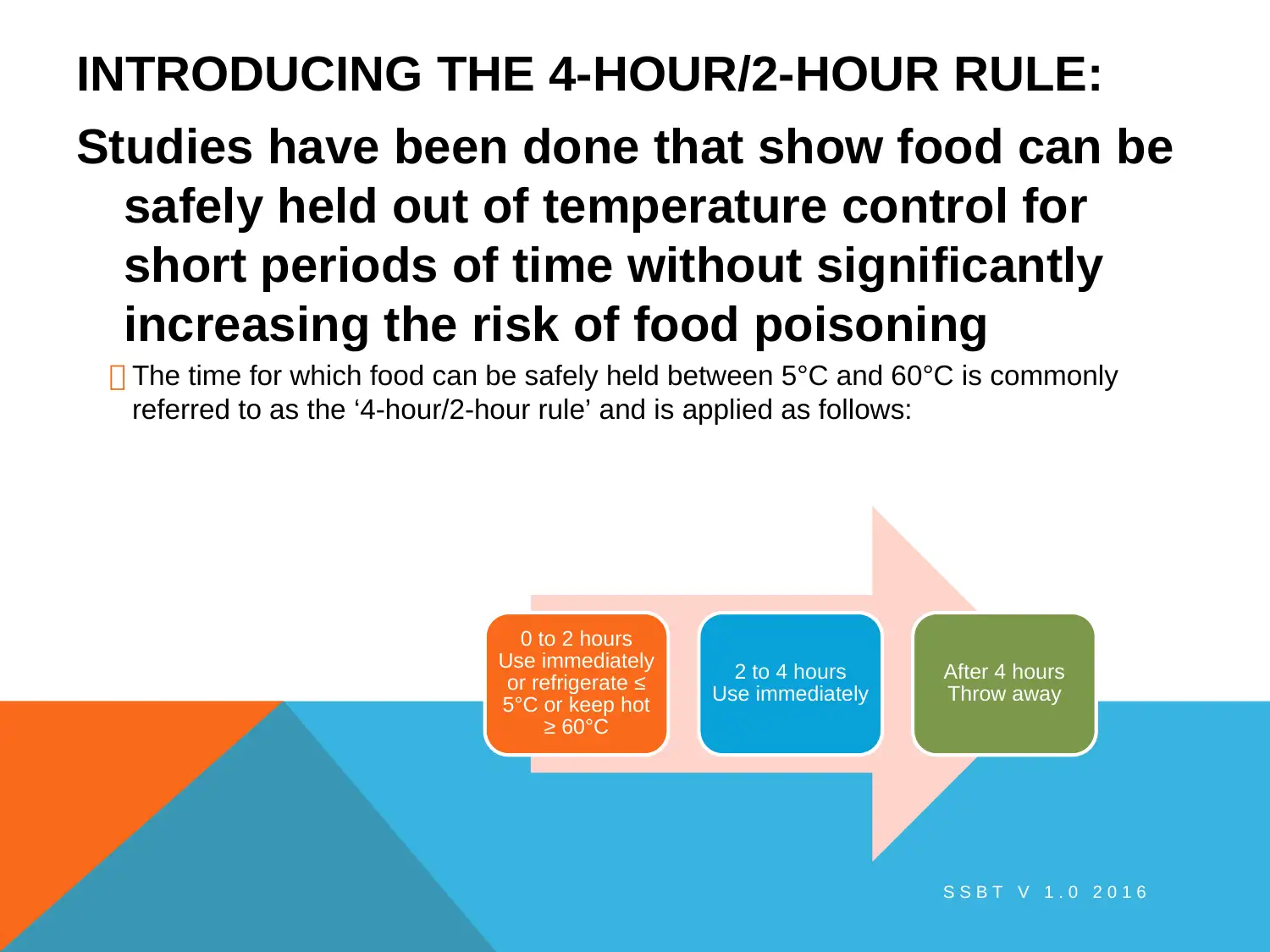
INTRODUCING THE 4-HOUR/2-HOUR RULE:
Studies have been done that show food can be
safely held out of temperature control for
short periods of time without significantly
increasing the risk of food poisoning
The time for which food can be safely held between 5°C and 60°C is commonly
referred to as the ‘4-hour/2-hour rule’ and is applied as follows:
S S B T V 1 . 0 2 0 1 6
0 to 2 hours
Use immediately
or refrigerate ≤
5°C or keep hot
≥ 60°C
2 to 4 hours
Use immediately
After 4 hours
Throw away
Studies have been done that show food can be
safely held out of temperature control for
short periods of time without significantly
increasing the risk of food poisoning
The time for which food can be safely held between 5°C and 60°C is commonly
referred to as the ‘4-hour/2-hour rule’ and is applied as follows:
S S B T V 1 . 0 2 0 1 6
0 to 2 hours
Use immediately
or refrigerate ≤
5°C or keep hot
≥ 60°C
2 to 4 hours
Use immediately
After 4 hours
Throw away
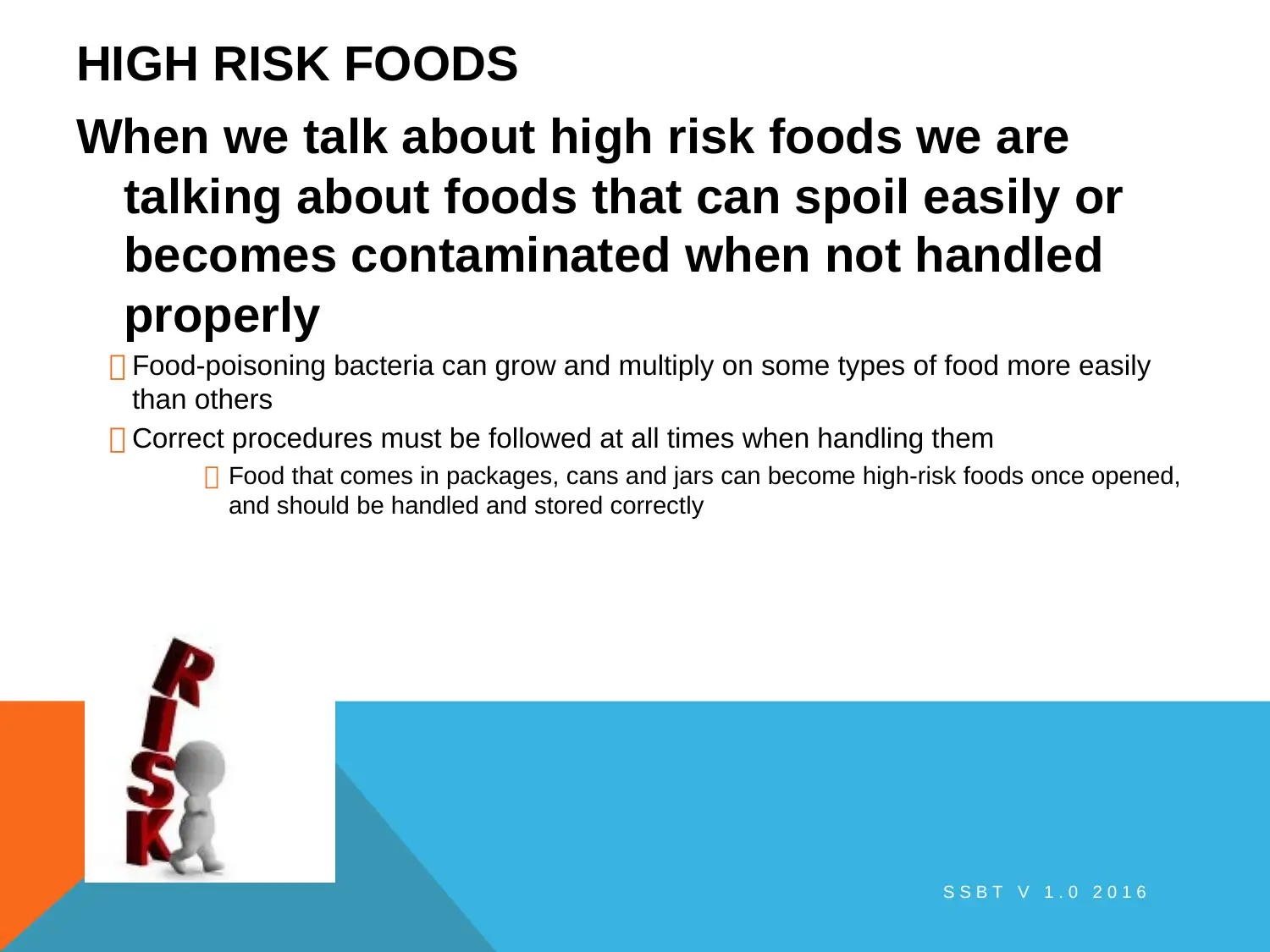
HIGH RISK FOODS
When we talk about high risk foods we are
talking about foods that can spoil easily or
becomes contaminated when not handled
properly
Food-poisoning bacteria can grow and multiply on some types of food more easily
than others
Correct procedures must be followed at all times when handling them
Food that comes in packages, cans and jars can become high-risk foods once opened,
and should be handled and stored correctly
S S B T V 1 . 0 2 0 1 6
When we talk about high risk foods we are
talking about foods that can spoil easily or
becomes contaminated when not handled
properly
Food-poisoning bacteria can grow and multiply on some types of food more easily
than others
Correct procedures must be followed at all times when handling them
Food that comes in packages, cans and jars can become high-risk foods once opened,
and should be handled and stored correctly
S S B T V 1 . 0 2 0 1 6
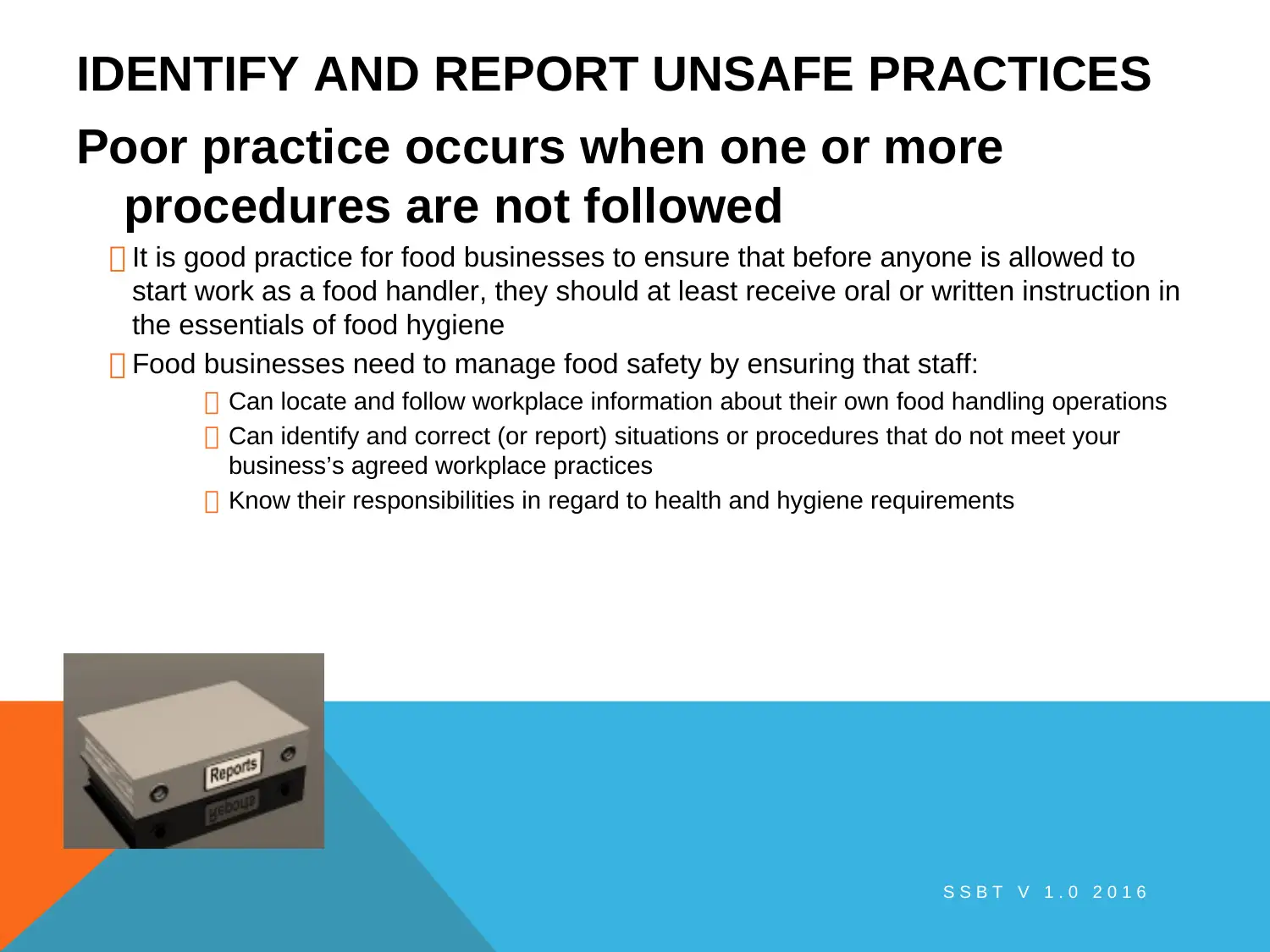
IDENTIFY AND REPORT UNSAFE PRACTICES
Poor practice occurs when one or more
procedures are not followed
It is good practice for food businesses to ensure that before anyone is allowed to
start work as a food handler, they should at least receive oral or written instruction in
the essentials of food hygiene
Food businesses need to manage food safety by ensuring that staff:
Can locate and follow workplace information about their own food handling operations
Can identify and correct (or report) situations or procedures that do not meet your
business’s agreed workplace practices
Know their responsibilities in regard to health and hygiene requirements
S S B T V 1 . 0 2 0 1 6
Poor practice occurs when one or more
procedures are not followed
It is good practice for food businesses to ensure that before anyone is allowed to
start work as a food handler, they should at least receive oral or written instruction in
the essentials of food hygiene
Food businesses need to manage food safety by ensuring that staff:
Can locate and follow workplace information about their own food handling operations
Can identify and correct (or report) situations or procedures that do not meet your
business’s agreed workplace practices
Know their responsibilities in regard to health and hygiene requirements
S S B T V 1 . 0 2 0 1 6
Paraphrase This Document
Need a fresh take? Get an instant paraphrase of this document with our AI Paraphraser
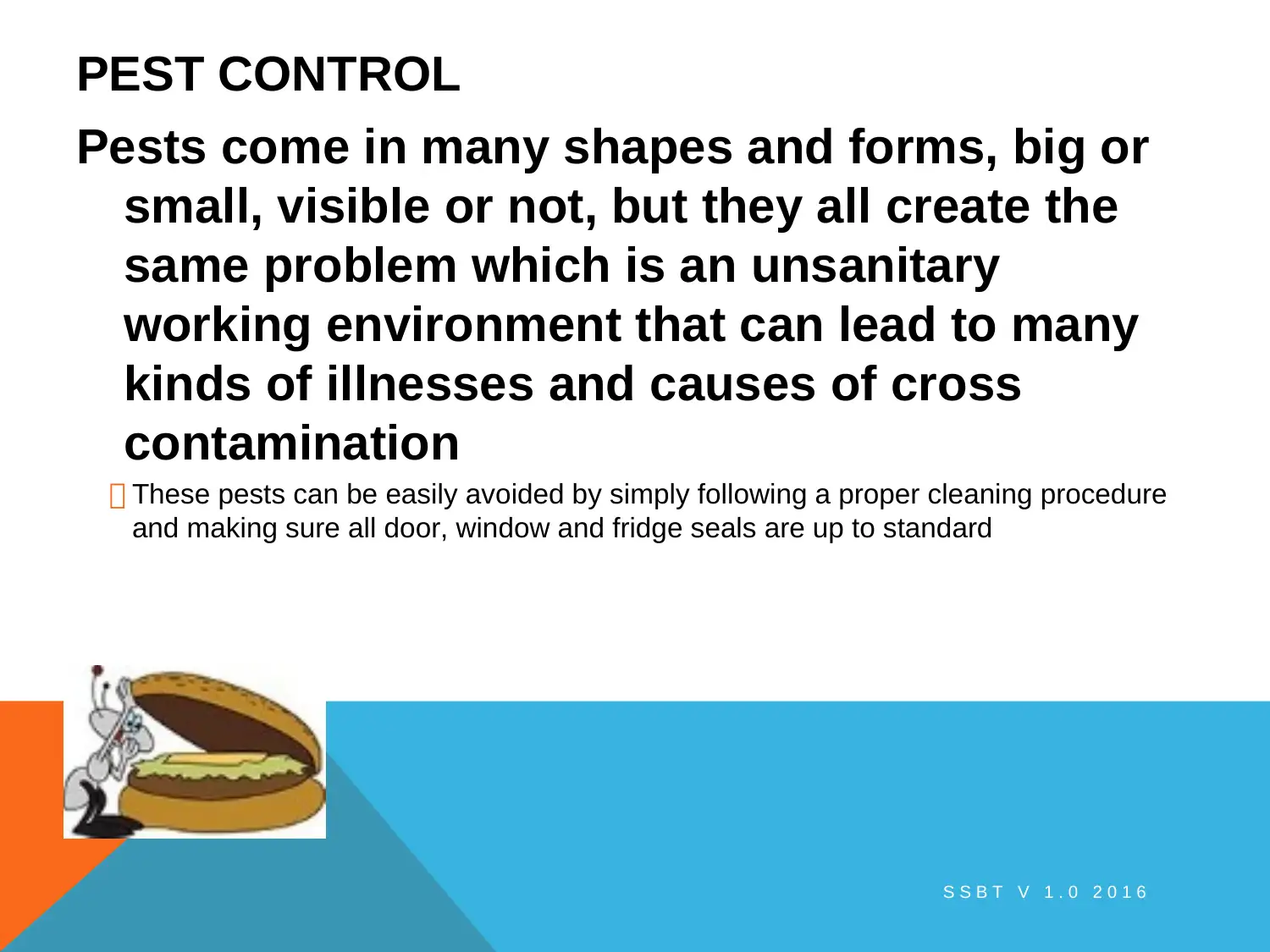
PEST CONTROL
Pests come in many shapes and forms, big or
small, visible or not, but they all create the
same problem which is an unsanitary
working environment that can lead to many
kinds of illnesses and causes of cross
contamination
These pests can be easily avoided by simply following a proper cleaning procedure
and making sure all door, window and fridge seals are up to standard
S S B T V 1 . 0 2 0 1 6
Pests come in many shapes and forms, big or
small, visible or not, but they all create the
same problem which is an unsanitary
working environment that can lead to many
kinds of illnesses and causes of cross
contamination
These pests can be easily avoided by simply following a proper cleaning procedure
and making sure all door, window and fridge seals are up to standard
S S B T V 1 . 0 2 0 1 6

TOPIC 2 - REPORT ANY PERSONAL HEALTH ISSUES
WHEN YOU ARE ILL
When you are ill you have a responsibility to
customers, clients and staff to ensure you do
not handle food
It is your duty not to contaminate food and surfaces to prevent passing on infectious
diseases to other people
If you become aware of any issues of possible food contamination caused by either
yourself or someone else it is your duty to report them as soon as possible
It is your responsibility to ensure reporting procedures are followed to maintain a safe
environment for staff and customers
S S B T V 1 . 0 2 0 1 6
WHEN YOU ARE ILL
When you are ill you have a responsibility to
customers, clients and staff to ensure you do
not handle food
It is your duty not to contaminate food and surfaces to prevent passing on infectious
diseases to other people
If you become aware of any issues of possible food contamination caused by either
yourself or someone else it is your duty to report them as soon as possible
It is your responsibility to ensure reporting procedures are followed to maintain a safe
environment for staff and customers
S S B T V 1 . 0 2 0 1 6
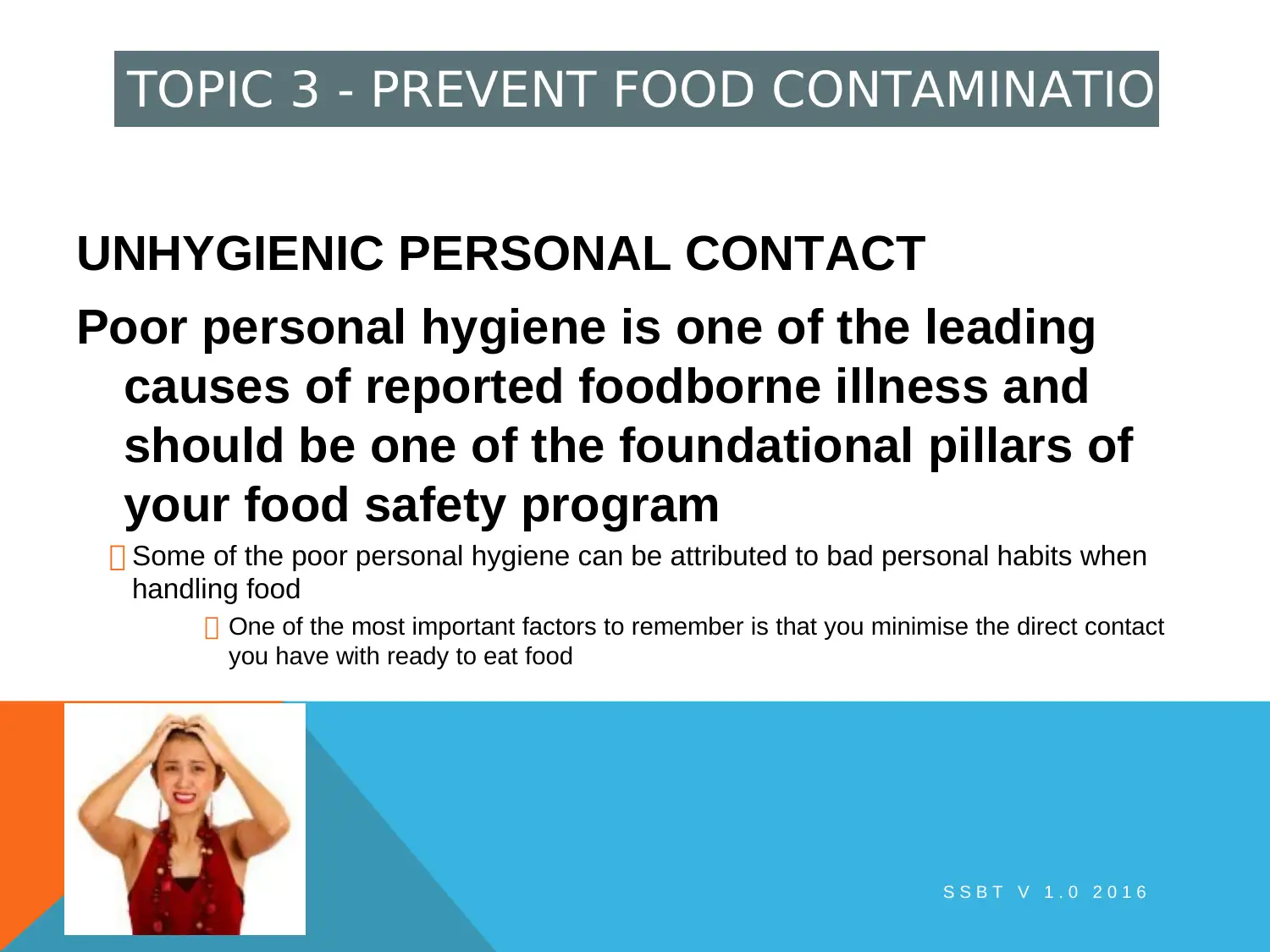
TOPIC 3 - PREVENT FOOD CONTAMINATION
UNHYGIENIC PERSONAL CONTACT
Poor personal hygiene is one of the leading
causes of reported foodborne illness and
should be one of the foundational pillars of
your food safety program
Some of the poor personal hygiene can be attributed to bad personal habits when
handling food
One of the most important factors to remember is that you minimise the direct contact
you have with ready to eat food
S S B T V 1 . 0 2 0 1 6
UNHYGIENIC PERSONAL CONTACT
Poor personal hygiene is one of the leading
causes of reported foodborne illness and
should be one of the foundational pillars of
your food safety program
Some of the poor personal hygiene can be attributed to bad personal habits when
handling food
One of the most important factors to remember is that you minimise the direct contact
you have with ready to eat food
S S B T V 1 . 0 2 0 1 6
Secure Best Marks with AI Grader
Need help grading? Try our AI Grader for instant feedback on your assignments.

PERSONAL HYGIENE
Personal hygiene is not only for self-
presentation but it also plays a key role in
maintaining hygienic food handling
techniques
Some of the key points to remember are:
Wearing clean clothes
Hair is tied back and a hat or hair net is covering any stray bits of hair
Wear disposable gloves and use tongs
Shower and wash hair regularly
Change gloves whenever you change activities and do not touch surfaces, equipment or
parts of the body while wearing them
Do not cough spit or sneeze on or near food
S S B T V 1 . 0 2 0 1 6
Personal hygiene is not only for self-
presentation but it also plays a key role in
maintaining hygienic food handling
techniques
Some of the key points to remember are:
Wearing clean clothes
Hair is tied back and a hat or hair net is covering any stray bits of hair
Wear disposable gloves and use tongs
Shower and wash hair regularly
Change gloves whenever you change activities and do not touch surfaces, equipment or
parts of the body while wearing them
Do not cough spit or sneeze on or near food
S S B T V 1 . 0 2 0 1 6

CLEANING PROCEDURES
Cleaning a kitchen regularly and thoroughly
removes materials that allow the growth and
spread of bacteria
A regular cleaning schedule should be in place in every
kitchen you work in, it tells you everything in the kitchen
that needs cleaning, how regularly it should be cleaned,
and when it was last cleaned
Food and rubbish should be disposed of as regularly as
needed
A standard cleaning process for pack down of any
area will consist of a basic skeleton structure you
can easily follow:
Pre-clean
Wash
Rinse
Sanitise
Polish and dry
Air dry
S S B T V 1 . 0 2 0 1 6
Cleaning a kitchen regularly and thoroughly
removes materials that allow the growth and
spread of bacteria
A regular cleaning schedule should be in place in every
kitchen you work in, it tells you everything in the kitchen
that needs cleaning, how regularly it should be cleaned,
and when it was last cleaned
Food and rubbish should be disposed of as regularly as
needed
A standard cleaning process for pack down of any
area will consist of a basic skeleton structure you
can easily follow:
Pre-clean
Wash
Rinse
Sanitise
Polish and dry
Air dry
S S B T V 1 . 0 2 0 1 6
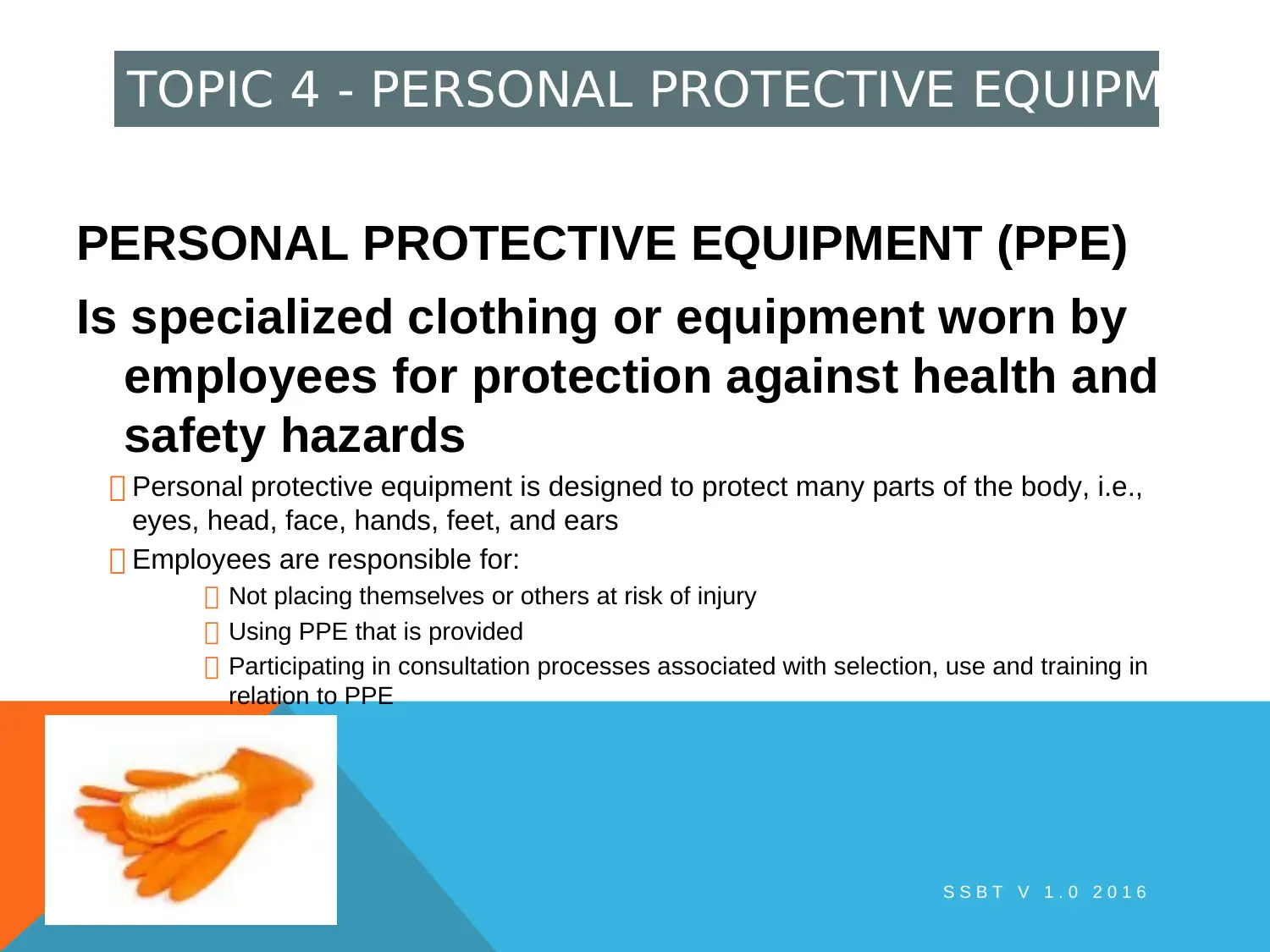
TOPIC 4 - PERSONAL PROTECTIVE EQUIPMENT
PERSONAL PROTECTIVE EQUIPMENT (PPE)
Is specialized clothing or equipment worn by
employees for protection against health and
safety hazards
Personal protective equipment is designed to protect many parts of the body, i.e.,
eyes, head, face, hands, feet, and ears
Employees are responsible for:
Not placing themselves or others at risk of injury
Using PPE that is provided
Participating in consultation processes associated with selection, use and training in
relation to PPE
S S B T V 1 . 0 2 0 1 6
PERSONAL PROTECTIVE EQUIPMENT (PPE)
Is specialized clothing or equipment worn by
employees for protection against health and
safety hazards
Personal protective equipment is designed to protect many parts of the body, i.e.,
eyes, head, face, hands, feet, and ears
Employees are responsible for:
Not placing themselves or others at risk of injury
Using PPE that is provided
Participating in consultation processes associated with selection, use and training in
relation to PPE
S S B T V 1 . 0 2 0 1 6
Paraphrase This Document
Need a fresh take? Get an instant paraphrase of this document with our AI Paraphraser
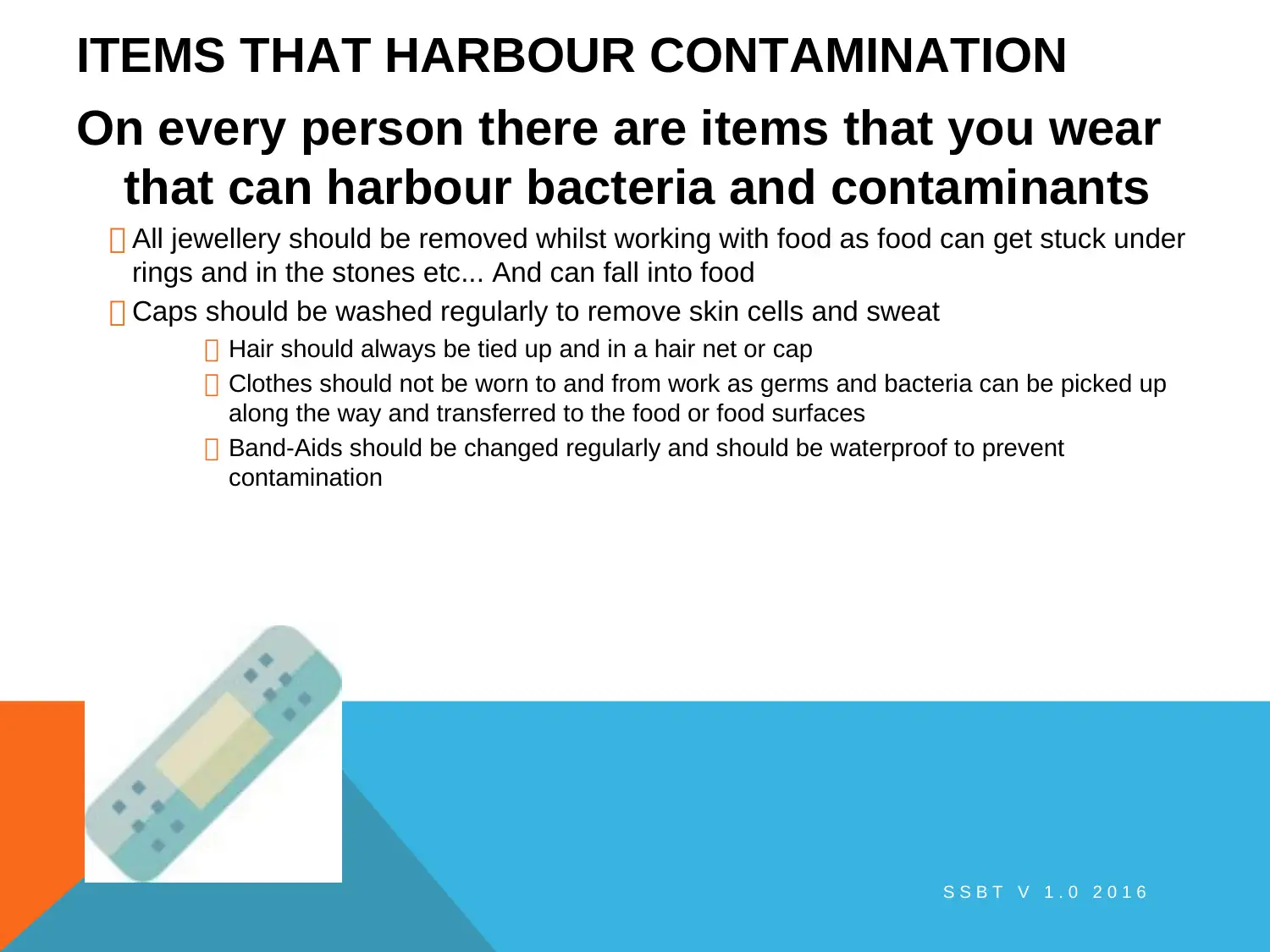
ITEMS THAT HARBOUR CONTAMINATION
On every person there are items that you wear
that can harbour bacteria and contaminants
All jewellery should be removed whilst working with food as food can get stuck under
rings and in the stones etc... And can fall into food
Caps should be washed regularly to remove skin cells and sweat
Hair should always be tied up and in a hair net or cap
Clothes should not be worn to and from work as germs and bacteria can be picked up
along the way and transferred to the food or food surfaces
Band-Aids should be changed regularly and should be waterproof to prevent
contamination
S S B T V 1 . 0 2 0 1 6
On every person there are items that you wear
that can harbour bacteria and contaminants
All jewellery should be removed whilst working with food as food can get stuck under
rings and in the stones etc... And can fall into food
Caps should be washed regularly to remove skin cells and sweat
Hair should always be tied up and in a hair net or cap
Clothes should not be worn to and from work as germs and bacteria can be picked up
along the way and transferred to the food or food surfaces
Band-Aids should be changed regularly and should be waterproof to prevent
contamination
S S B T V 1 . 0 2 0 1 6
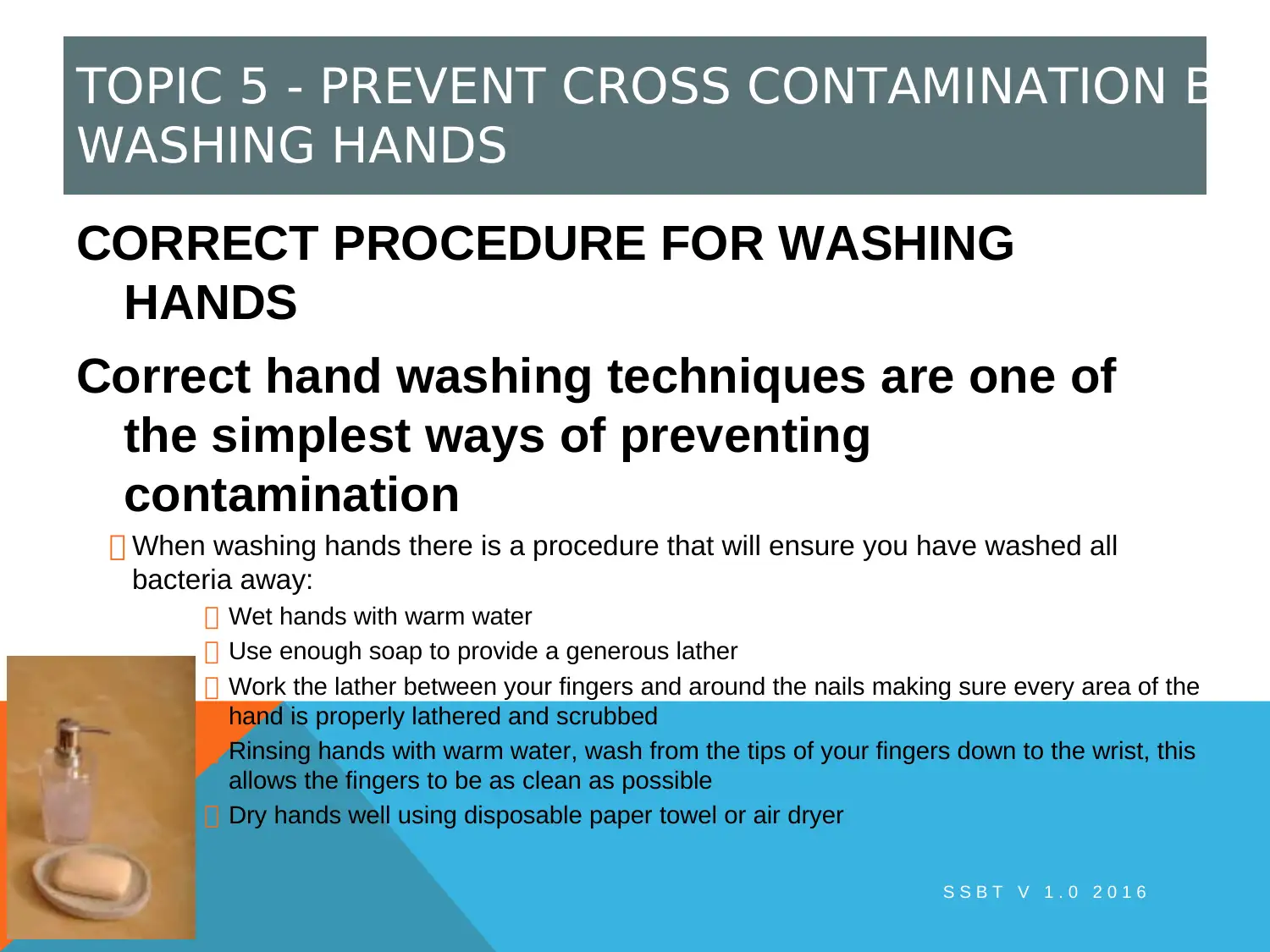
TOPIC 5 - PREVENT CROSS CONTAMINATION BY
WASHING HANDS
CORRECT PROCEDURE FOR WASHING
HANDS
Correct hand washing techniques are one of
the simplest ways of preventing
contamination
When washing hands there is a procedure that will ensure you have washed all
bacteria away:
Wet hands with warm water
Use enough soap to provide a generous lather
Work the lather between your fingers and around the nails making sure every area of the
hand is properly lathered and scrubbed
Rinsing hands with warm water, wash from the tips of your fingers down to the wrist, this
allows the fingers to be as clean as possible
Dry hands well using disposable paper towel or air dryer
S S B T V 1 . 0 2 0 1 6
WASHING HANDS
CORRECT PROCEDURE FOR WASHING
HANDS
Correct hand washing techniques are one of
the simplest ways of preventing
contamination
When washing hands there is a procedure that will ensure you have washed all
bacteria away:
Wet hands with warm water
Use enough soap to provide a generous lather
Work the lather between your fingers and around the nails making sure every area of the
hand is properly lathered and scrubbed
Rinsing hands with warm water, wash from the tips of your fingers down to the wrist, this
allows the fingers to be as clean as possible
Dry hands well using disposable paper towel or air dryer
S S B T V 1 . 0 2 0 1 6
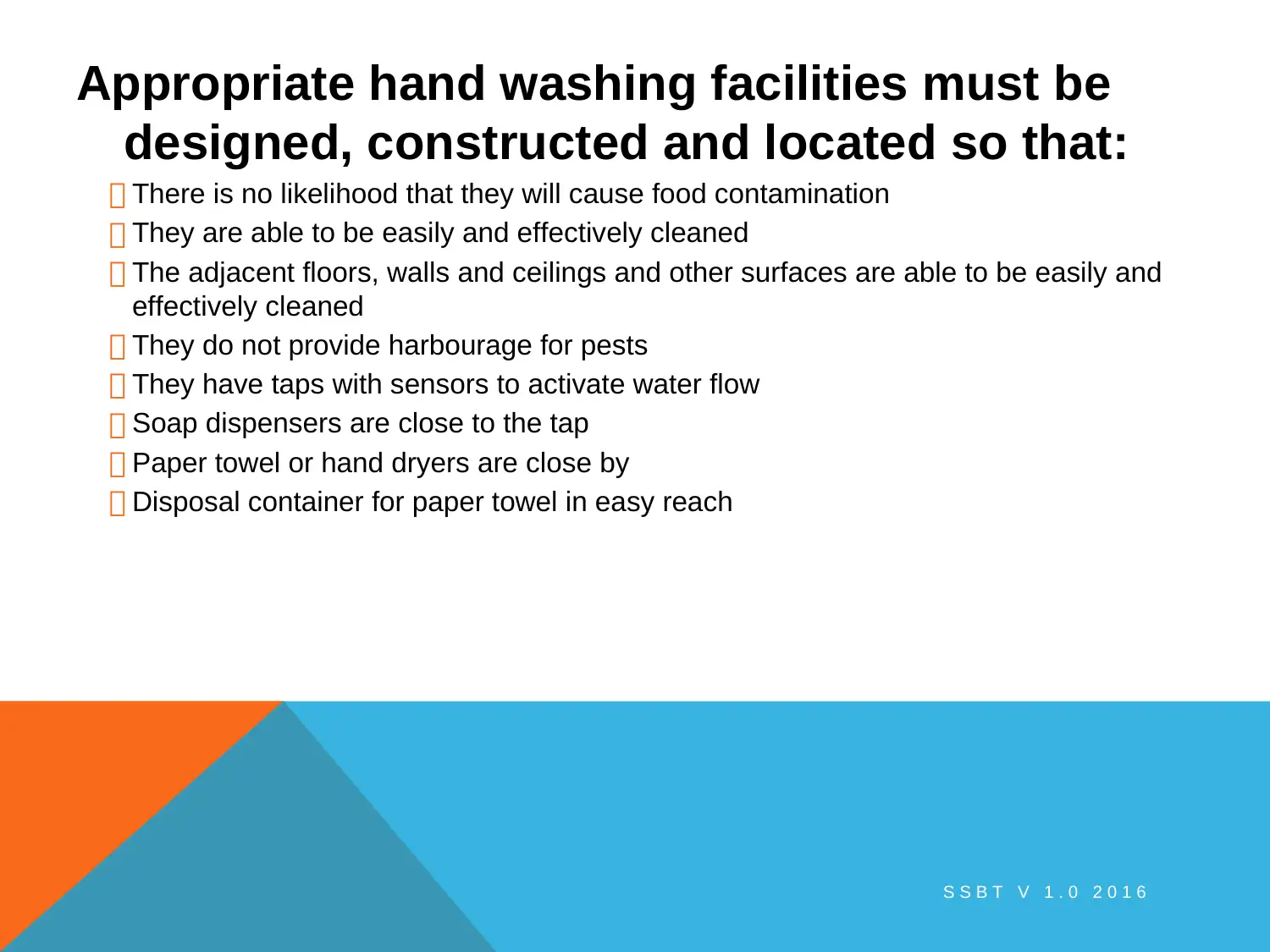
Appropriate hand washing facilities must be
designed, constructed and located so that:
There is no likelihood that they will cause food contamination
They are able to be easily and effectively cleaned
The adjacent floors, walls and ceilings and other surfaces are able to be easily and
effectively cleaned
They do not provide harbourage for pests
They have taps with sensors to activate water flow
Soap dispensers are close to the tap
Paper towel or hand dryers are close by
Disposal container for paper towel in easy reach
S S B T V 1 . 0 2 0 1 6
designed, constructed and located so that:
There is no likelihood that they will cause food contamination
They are able to be easily and effectively cleaned
The adjacent floors, walls and ceilings and other surfaces are able to be easily and
effectively cleaned
They do not provide harbourage for pests
They have taps with sensors to activate water flow
Soap dispensers are close to the tap
Paper towel or hand dryers are close by
Disposal container for paper towel in easy reach
S S B T V 1 . 0 2 0 1 6
Secure Best Marks with AI Grader
Need help grading? Try our AI Grader for instant feedback on your assignments.
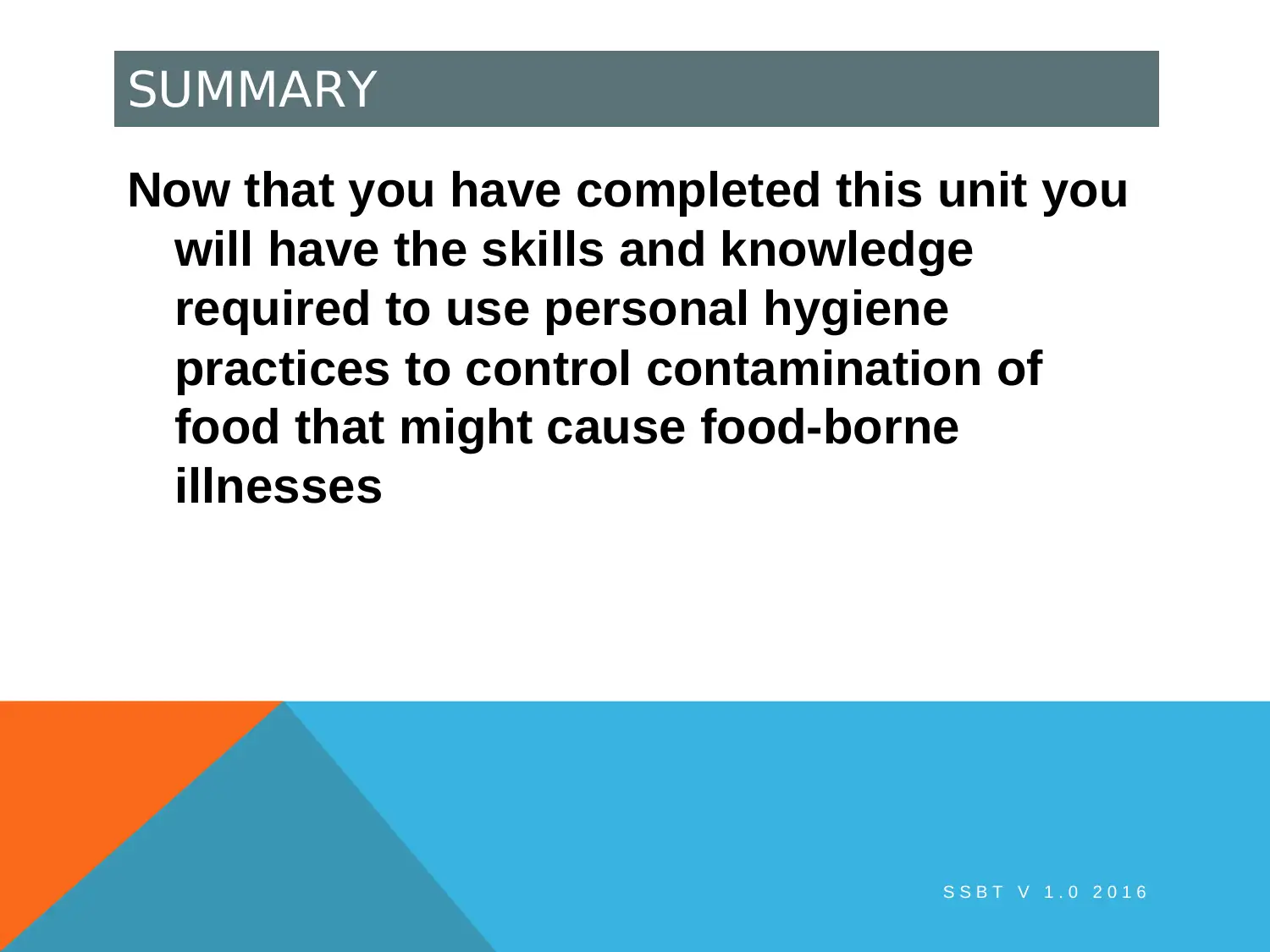
SUMMARY
Now that you have completed this unit you
will have the skills and knowledge
required to use personal hygiene
practices to control contamination of
food that might cause food-borne
illnesses
S S B T V 1 . 0 2 0 1 6
Now that you have completed this unit you
will have the skills and knowledge
required to use personal hygiene
practices to control contamination of
food that might cause food-borne
illnesses
S S B T V 1 . 0 2 0 1 6

S S B T V 1 . 0 2 0 1 6
1 out of 24
Related Documents
Your All-in-One AI-Powered Toolkit for Academic Success.
+13062052269
info@desklib.com
Available 24*7 on WhatsApp / Email
![[object Object]](/_next/static/media/star-bottom.7253800d.svg)
Unlock your academic potential
© 2024 | Zucol Services PVT LTD | All rights reserved.





